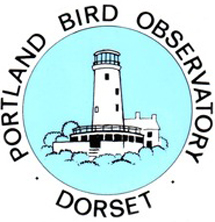Weekly round-up: 26 Aug - 01 Sep 2015
The new week’s weather was, very much, picking up from where a blustery 25th had left off - a brisk southwesterly airflow spinning through the upper edges of the Western Approaches; only when conditions calmed a little would the avian pot of gold emerge from below the damp rainbows…
As the Atlantic front eased away, a short interlude of brighter, warmer, sunnier weather followed along behind and conditions started to favour the east coast once more - the drift migrants, and rarer options too, following along on the coat tails of a bit of continental high pressure and suitably southeasterly type winds.
Those winds trundled slightly further to the south by the weekend and pulled in not only warmer weather across the south and southeast but also a few unexpected overshoots too but as the Bank Holiday loomed there was yet another change as rain clouds were strewn from the northwest to East Anglia - and boy did it rain (Weybourne’s weather station recording one of the wettest August days for decades).
The genuinely mixed bag of weather had one final change up its sleeve. As the heavy precipitation dissipated over the North Sea, then a coller somewhat more settled (if slightly breezey) Northerly airflow took over as September was ushered in with sunny spells and a cooler wind than of late. And with the settled conditions came another small pulse of further drifters.
Three magical words for seawatchers anywhere around the coasts of Britain and Ireland. Three magical words which would, doubtless, have been condensed down to a primeval, guttural roar, an unholy expletive and a tri-syllabic “TROP-IC-BIRD” on the morning of 28th on top of the cliffs at Gwennap Head, Porthgwarra.
Martin Birch’s cracking account of an unforgettable few minutes can be seen here - but a brief-ish précis follows. First noted at around 8am, the bird was watched for five minutes or so as it circled and drifted back and forth inside the Runnelstone buoy and unlike an altogether more-infamous Cornish record of recent times, this particular Red-billed Tropicbird was seen by around a dozen observers - lucky many would say - others would nod at their perseverance to the cause of seawatching on the third or fourth day of reasonable Cornish conditions - and Porthgwarra is a long way from anywhere, so if you good luck to you if you were there, efforts duly rewarded.
Red-billed Tropicbird has been mired in controversy every since it came on to the listing radar after the first occurrence on June 7th 2001. That bird, that photographed bird, was seen by non-birders aboard the sailing vessel Marg A Rita, some 25 miles to the south southeast of Scilly but, despite much evidence being provided, the birding police even inspecting “captain’s log” for absolute confirmation as EXIF data was poured over, doubts remained for many, many months after acceptance.
Those on board did seem to provide utterly conclusive evidence and fabrication was, rightly, dismissed.
Less than 12 months later, on the perhaps at first glance, unlikely date of March 29th 2002, Scilly Alpine Swift twitchers on board the M.V. Scillonian saw a Red-billed Tropicbird some four miles to the east of the islands - a grainy, moderately unconvincing (no disrespect, its just not a great shot…) image came along with the description - all of which proved enough for the BBRC - Britain’s second record was made official.
Less than a month later (and giving yet more credence to the sometimes doubted Scilly bird) came another at-sea record, around a mile off The Lizard, on April 21st 2002 - Sea Area Sole & Scilly 2, Cornwall 1.
Seven years elapsed until the next record - a photographed bird was seen from a boat less than 20 miles offshore of the Old Head of Kinsale (Co. Cork) on September 8th 2009 and then came the one that everyone still talks about…
The Sunday morning of August 18th 2013 was a no brainer - the Atlantic weather system that had trundled rapidly through the Western Approaches saw forecasts suggest a rapid switch to a westerly direction and that meant that Pendeen was the place to be.
A sizeable crowd had gathered along the lighthouse wall and the proceedings were actually rather slow, despite the decent weather that was coming through. A bunch of Storm Petrels around the rocks were seemingly responsible for every birder failing to see the stunning Red-billed Tropicbird that passed by almost underneath them all, sometime around 0845. How did they know what had happened? Well, one birder had wandered down the slope to the seaward side, away from the crowd and had begun to take photos of the birds passing close inshore. One of them was a Red-billed Tropicbird! No one else was aware of what happened until a casual glance at some “BOTC” (Back of The Camera) shots were met with jaw-dropping consternation and what must have been the single most collective bout of gut-churning bird-induced nausea ever known…
A forecast of moderate, south westerly winds had governed that I try my luck for an annual August trip, seawatching in Cornwall, hoping for the big one. And so to Gwennap Head, Porthgwarra, from Tuesday 25th, putting in a daily shift from 6.30am to 8.00pm.
Cory Shearwaters had been numerous each day, good numbers of Great Shears, Balearics, Stormies and a few Skuas had been entertaining the assembled birders. Late Tuesday evening, a very credible candidate for Yelkouan Shearwater rewarded we five hardy remaing stalwarts, but as in The Tales from the Riverbank..."that's another story."
Things quietened down during the afternoon of Thursday 27th, a Minke Whale being the very welcome highlight. For me, a sleep-in was over due and thus I arrived at PG "late" at 7.30am on Friday 28th.
11 visiting birders had already gathered, scattered among the rocks at Gwennap Head. I was surprised they had already tallied 50 Cory's dawdling slowly West. At around 8.05am, Martin Birch urgently exclaimed "Get on this bird... Look at this" or something of that ilk. He efficiently directed us on to a lone bird that was already West of the Runnel Stone bouy. As I, Jeff Burgham, James Garside and others got on to it, the bird was flying directly away from us and it appeared to show the tri-coloured wing pattern of an adult Sabines Gull. Several of us, confidently said Sabines but Martin was not happy with that saying it had a long tail, a feature we couldn't see at this angle, he mentioned Tropicbird as a possibility, with that, the bird banked right, clearly revealing itself as a Tropicbird.
A thump of adrenaline surged through me like a lightening bolt, Martin and I shouted Red-billed Tropicbird.
Incredibly, the bird circled back towards the coast and returned towards us, within about half distance from shore to the Runnel Stone bouy, although, off to the West of our viewpoint. It was flying about 10-15 metres above the sea and investigated several Gannets, flying directly to them, and following them for short periods. It had a steady, constant flapping action. As the bird first banked right, and subsequently as it circled, we could see a pale orange bill, black mask through the eye, a substantial black wedge formed by the outer primaries, white triangular trailing edge to the wing from the inner primaries and secondaries and pale grey coverts, the white tail had protruding central tail feathers that extended beyond the rest of the tail by about an additional half to three quarters of the tail length, it circled for approximately 7 minutes gradually heading West, at one point it had travelled out if view behind the rocks to our right but came back in to view, flying out to sea again.
Amld all the high excitement, swearing, and repeated directions, all 12, physically shaking birders got on to the bird. A cliff top telephone conversation I had with Ian Lewington, describing the birds features and plumage, would strongly suggest it was a 2nd calender year Red-billed Tropicbird, differing from adult due to bill colour - pale orange as opposed to red, its tail length- nit having full length tail streamers, and from a juv by lack of any dark scalloping in mantle/coverts, and again bill colour- pale orange whereas yellow in juv.
Great credit must go to Martin Birch for the initial call and sticking to his first thoughts/impressions on the bird.
Manic phone calls and text messaging followed the sighting, trying to get the news out in case the bird followed the the Landsend coastline.
This was followed by, hurried, joyous, congratulatory conversations as the dozen visiting individuals were united in a moment of exhilarating triumph.
I'm writing this account sat in the Logan Rock, Treen, benefitting from WiFi and a pint of Tribute. I'll be in West Penwith for the coming days, sat on a cliff top...watching...waiting...smiling.
August in Cornwall...I'll be back next year.
Geoff Wyatt, Oxon.
There was much rancour and disbelief throw in to the online pot, invective and “WTF” spewing forth like the swirling white spume cast on to the treacherous Cornish cliffs. How all bar one of some 80+ birders gathered at Pendeen managed to miss the R-bT is one of those birding mysteries that will linger a long time, particularly for all those gathered at Pendeen that day - but these things do happen and, unless you were sitting there, it is easy to ask questions from a far. The truth is often the most painful thing to have to accept and as the photos finally came to light, acceptance was all that could follow (in every sense).
One of those things…just one of those things…but goodness, for those 79 souls who were there and didn’t connect, that’s a lot of pain to endure.
Bright side? Well…five acceptances of four or five birds with the space of 11 years is encouraging for sure. Now we have another one to deal with too. Cornish waters and those off Scilly remain the optimum sea areas - but there’s a lot of sea and there’s an awful lot of luck and fortitude required to nail this dream-like species for a British or Irish list.
At some point, there will be a mass-observed Red-billed Tropicbird, more than the “PG 12” of this week - boy, when it happens we’ll know all about it. Until then, it’s a doff of the cap to those birders perched up on high - fair play one and all.
Playing a somewhat rickety second-fiddle to the magnificent PG T-Bird is the second Pendeen Watch Barolo Shearwater of the year - this one spending some three minutes offshore from the coastal hotspot, heading west throughout.
It follows on from the single observer bird of July 29th - all the relevant stats., for the species can be found in that week’s review…
Somehow feeling all the more exciting than the Cornish bird was the news of the week’s second Barolo Shearwater - this one noted from Pembrokeshire’s premier seawatching spot, Strumble Head. The bird moved through just before teatime on 31st with finder Richard Stonier’s online account proving to be almost as gripping as the T-Bird tale.
BAROLO !!! http://t.co/ah6WoFAbkv @wdigbirder_ @RareBirdAlertUK
— Richard Stonier (@birdsonline001) August 31, 2015There are eight previous records of this notorious seabird for the west Wales county - the first famously spent a couple of summers in the Skomer shearwater burrows in 1981 and 1982 but, since then, the six remaining records have all come from Strumble. Single sightings came in consecutive autumns from 1982 to 1984, then two were seen on October 7th 1988. One followed on the late-ish date of November 5th 1989 then came a gap until September 1997 for the next record. Now, almost 18 years further down the line comes Pembrokeshire’s 9th in all.
Still proving to be something of a rather alluring headliner again this week, the juvenile Pallid Harrier on Shetland’s south Mainland - seven days ago, the review mentioned that it appeared at the Loch of Spiggie, this week, Hugh Harrop was on hand to grab a shot of what (first thoughts at least) was presumably the same bird not too far away at Durigarth, near Boddam on 27th.
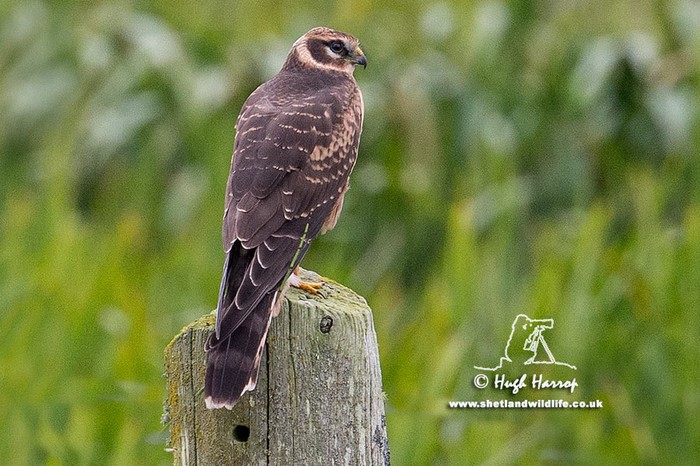
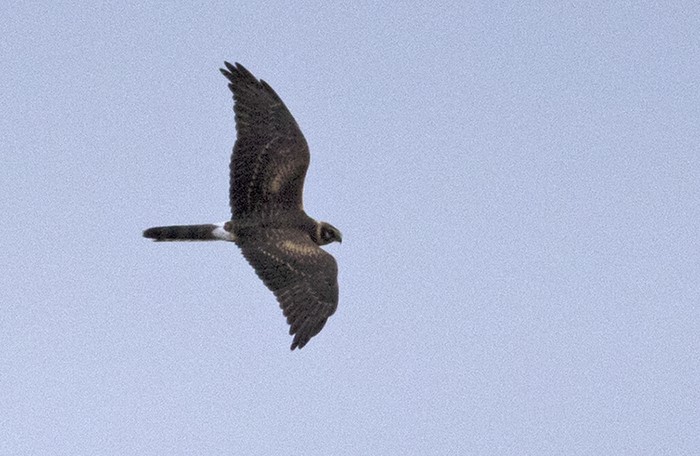
Then, incredibly, there were two! Both juveniles, this unique double were seen not too far away from either of the initial August sightings, this tome between Hillwell and Brake on the evening of 30th - the first time two have been seen together in Britain (though at one point in invasion of September 2011, up to three different juveniles were logged around south Mainland on Shetland). At least one of these youngsters was seen again the following evening.
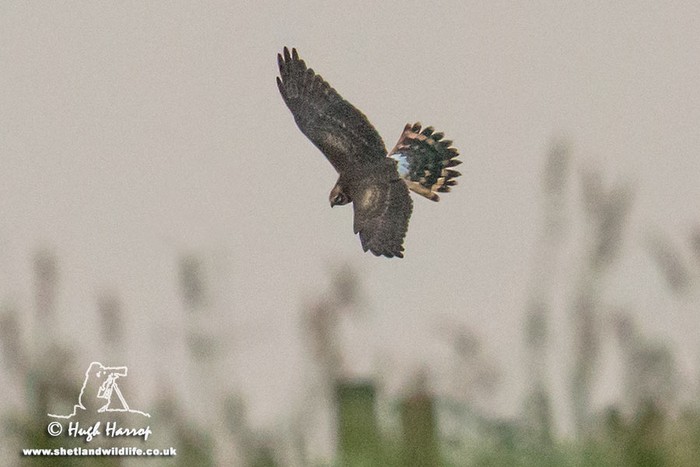
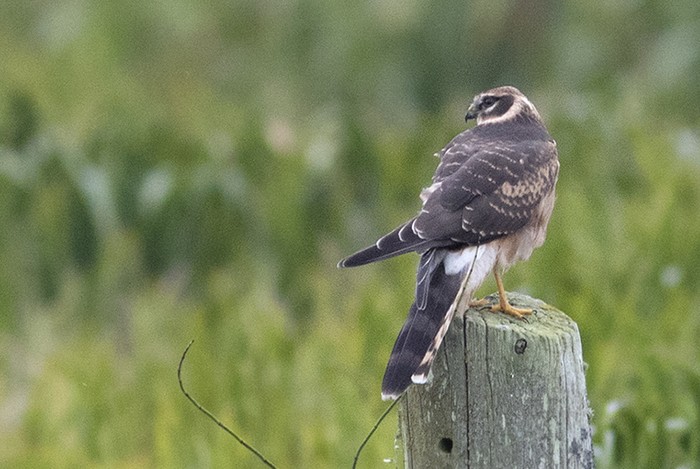
The ultra-kudos and aura surrounding this species may have dissipated like early autumn dew in the late August sunshine but this remains one heck of a rare.
Birders living in Scotland far northeastern corner have been enjoying a particularly fine little purple patch through the last 10 to 14 days or so - along with leggy storks and wing-barred warblers, a new high-quality county rarity was discovered in the churchyard at Collieston on 29th - a fine Paddyfield Warbler, just the second county record for Aberdeenshire.
It was actually only three years ago that this species made its debut in the region, an adult being trapped alongside the Ythan Estuary on September 8th 2012. This week’s bird is the second this month (following on from the obliging bird on Noss) and the third Paddyfield of the year - the first was the June bird found on Norfolk’s Blakeney Point.
The two birds recorded in the last four weeks take the total of August arrivals to seven and joins 2010 as the only other year to have scored two birds within the month.
Here’s a species that isn’t really renowned for appearances at the “top table” that is spread before you week after week, but there’s no doubting the “wow!” moment that followed quickly after seeing that a flock of 17 Cattle Egretshad been found at Coward’s Marsh (Dorset) during the late morning of 30th. As the AM became the PM it was established that the 17 were actually now a monster 23 - a record-breaking assemblage!
This impressive gathering lingered until just before 6pm, when they took flight to the north and then, 25 minutes later, they were seen heading up the Avon River valley, at Iblsey (Hampshire). The following day, two were seen elsewhere in Hants., at Normandy Marsh and two were back at Coward’s Marsh as well, where they stayed to 1st.
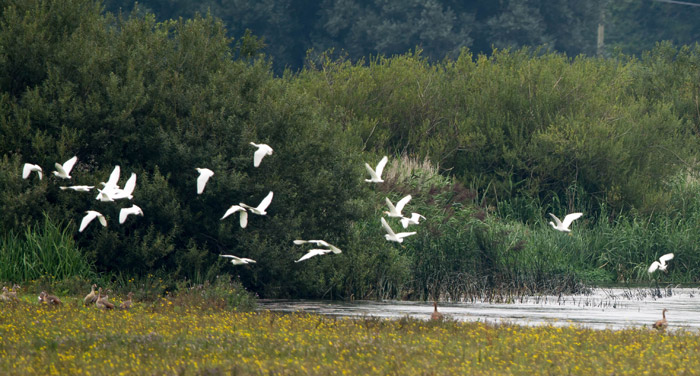
This is a species that left the BBRC Rarities List almost seven years ago and is also an occasional (former?) breeding species here - it is also known for a remarkable winter invasion during late 2007 and early 2008; goodness knows how many birds were actually involved but from November 1st to December 31st 2007 an amazing 50 records were accepted (of over 100 birds) and even with some duplication it remains a remarkable total, with many multiples involved too…
The first birds of the two-month Cattle-Fest were four birds that were found on the edge of Poole Harbour on November 2nd. Across the next week, sightings came from Glamorgan, Dorset (a new loner) and Wicklow. A gap of nine days followed, with a single arriving on Scilly and then on 20th, a flock of 18 birds was located at Sancreed, near Drift, in west Cornwall. Several multiples followed elsewhere in southwest England and also in southwest Ireland, where nine were seen around Clonakilty from December 27th.
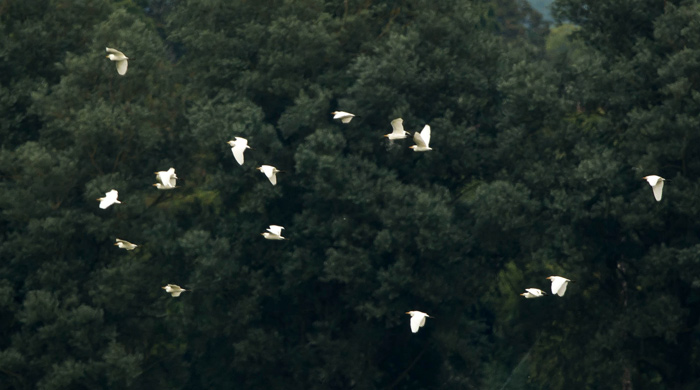
By the end of December, the two month arrival saw some 118+ birds spread across 15 English counties, six Irish counties and also one in both Wales and Scotland. The first few weeks of 2008 saw more birds revolve around the country and more arrive too - the Sancreed Cattle Egret flock peaked at an amazing 20 while Cork’s highest score was a flock of 12 at Carrigaline on January 22nd. Waterford popped in an 11 near Stradbally at the end of January and records kept flowing throughout the year - an enormous 175 accepted for 2008 - a figure that, along with the total of 65 acceptances in 2007 (a combined total that accounted for over half of all records here) precipitated the departure from the Rarities List.
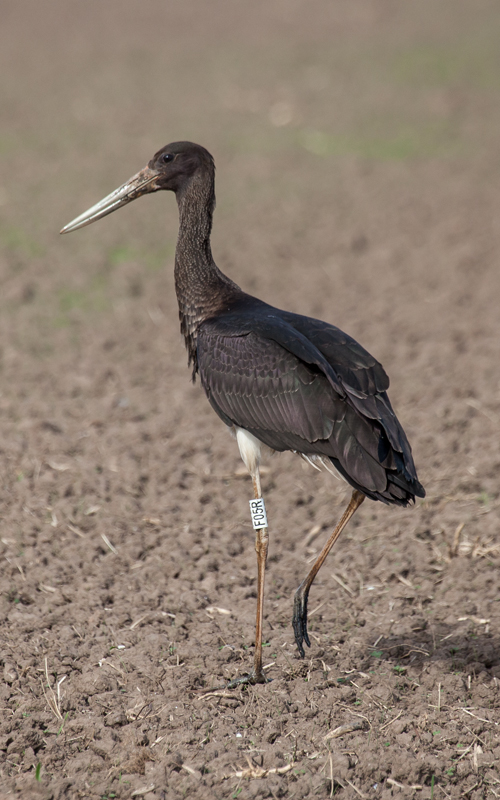
(© Robert Wilson)
Black Storks continue to provide much of the week’s value and, as with other recent weeks there were three on offer once more - this time, there was new territory to report from…
…because during the early afternoon of 28th, a Black Stork headed south over Landguard NR (Suffolk) and was seen, a couple of hours or so later, in and around Clacton-on-Sea in next door Essex. Quite which bird from the past month this could be is anyone’s guess - it could, of course, even have been a newbie.
This is the second record in Suffolk this summer - a juvenile reported at Wenhaston on July 28th could well have been the first individual of this summer’s fascinating mini-invasion - while this week’s Landguard bird should become the 20th record for the county (the only blank year lately in Suffolk has been 2012). Essex has fared less successfully with the species over the year, nine records in all (until this week) with the only birds since the start of the 2000’s being recorded in May 2002, August & September 2004 and June 2008).
Elsewhere “old favourites” from recent weeks were noted again in East Sussex, this time at Crowhurst on 29th and then again at Cooden on 30th and 1st, while along the Humber Estuary, the French juvenile “F05R” appeared to have bid “au revoir” to East Yorkshire on the morning of 30th, circling high above the temporary residence of Sunk Island and Stone Creek during the middle of the morning and heading off south. It was presumably this bird that was seen on the morning of the 1st of the mew month at Cleethropes (Lincolnshire) but by the afternoon it was business as usual again at Stone Creek.
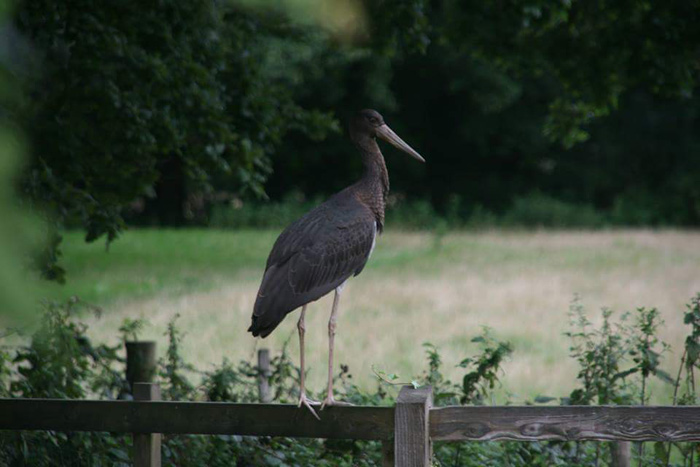
The favourable seawatching conditions that began to kick in across southwestern England and southwestern Ireland at the very end of last week’s review period continued undiminished into 26th (and we know just what they produced as a spectacular grand finale a couple of days later) with a decent mix of species logged at a few sites and, although the “biggie” was absent on what would be perceived as “the day”, it was clearly still worthwhile casting eyes out across the near extremities of the Atlantic Ocean. First stop, County Cork.
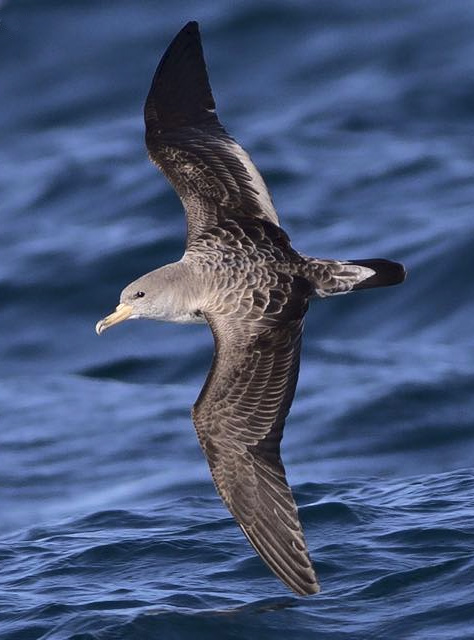
Galley Head seawatchers had a suitably lively morning seawatch on 26th - over 700 “big shears” counted from 0735-1125, the highest aggregate score of the year to date. The Cory’s Shearwater total nestled at 383 for just-under four hour session, while 326 Great Shearwaters were also logged along with two Pomarine Skuas and a couple of Balearic Shearwaters as well. Clearly passage had eased significantly come the afternoon, just eight Cory’s and four further Greats recorded. Still, not a bad return for your time...
Numbers of those eternally popular big shearwaters may not have been in the figures noted from the coast of Cork, but birders gathered at Porthgwarra for the day came away with a varied, entertaining looking haul by the look of things.
Leading the way, a count of 57 Cory’s Shearwaters, with three Great Shearwaters lagging along in second place. As usual for such conditions, there was a good, solid tally of Balearic Shearwaters recorded, 103 seen by the end of the day, while there were also one each for both Long-tailed Skua and also Pomarine Skua.
As the crow flies (or the shearwater…) Kynance Cove isn’t a huge distance from Porthgwarra, so it was interesting to see the former’s impressive lunchtime hour count of 53 Cory’s Shearwaters - just four behind the entire day’s haul from the famed PG. Elsewhere on the Cornish mainland, nine Cory’s and half a dozen Great Shearwaters (along with nine Balearics were seen from Lizard Point in a 90 minute afternoon session.
Over the seas to Scilly, where 38 Cory’s Shearwaters were seen from Horse Point, St. Agnes in two hours while the Scillonian crossing back to the Cornish mainland threw up at least 10 Cory’s and also a couple of Sabine’s Gulls for good measure.
Balearic Shearwaters were recorded from nine English and four Irish counties during 26th - two south Devon headlands faring particularly well; 246 counted from Prawle Point with 208 from Berry Head, while somewhat lower county counts came from Teignmouth, Slapton (ten each there) and Budleigh Salterton (eight seen there). Along with Porthgwarra’s 103, Cornwall also managed to see a second three-figure count posted thanks to the 177 off Rame Head. A further 11 were logged elsewhere in the county as well.
Drifting along the south coast, a further 55 were seen from Portland Bill (with eight more along the rest of the Dorset) while West Sussex managed four and East Sussex c.25 in all. In Kent, a great count came from Dungeness where 92 Balearics were seen through to the middle of the afternoon while birds also made it around the corner to both Essex and Suffolk. Low single figures were also noted in Clare, Kerry, Cork and Waterford.
Birders at Bridges of Ross, in County Clare, didn’t manage a single large shearwater during 26th, but did manage a single Leach’s Storm-petrel, half a dozen Grey Phalaropes and a couple of Pomarine Skuas.
Along with the Long-tailed Skua already mentioned for Porthgwarra, another for 26th passed Berry Head while Pomarine Skuas were also in fairly short supply as well, just 15 seen in all (including those mentioned already from Ireland’s southwest and west coasts). English singles were spread from Cornwall and Devon to Kent (with a late five noted from Dungeness) and Lancashire, while Wales and Scotland logged one each, off Gwynedd and Ayrshire.
The signs were there that it was really worth sticking at things in Cornwall and Cork as the weather just kept on giving. Events of the morning of 28th were a magnificent climax to the proceedings (how on earth do you top a Tropicbird?) and you could almost see things building to an almighty wafty-tailed crescendo (no matter how surprising it may have been).
Yes, with a decided lack of further mentions of the “T-Bird” there’s a semblance of “back to normal” where our seabirds are concerned and there was much on offer to keep fans of all-things pelagic more than happy across the seven days just gone.
From aboard the M.V.Sapphire, another Wilson’s Storm-petrel was logged on the evening jaunt out of St. Mary’s on 27th while two more were recorded from a pelagic out of Cork’s Baltimore on 29th.
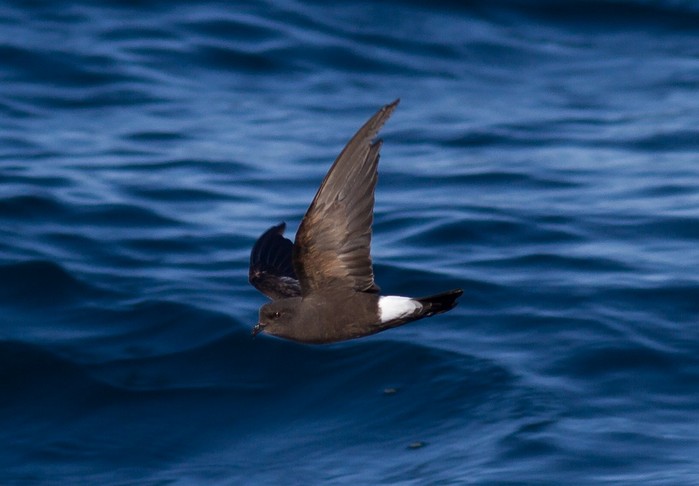
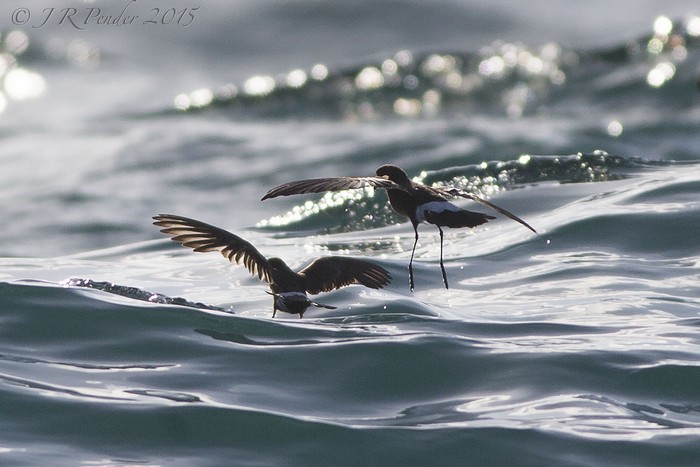
…and, by the way, hat’s off to Scilly skipper Joe Pender for his gorgeous backlit, “bouncing” image of the Wilson’s mentioned above - stunning and so pleasingly different too…
Post August 26th, numbers of Great Shearwaters tailed off considerably, although a further 78+ were logged off the coast of Cork, including 40 through the day on 29th off Galley Head and a further 20 at sea from the Baltimore pelagic of 29th. Just three more were noted from Porthgwarra through the week, while in Scilly waters a single was seen from an evening pelagic on 27th with two seen from the Scillonian sailing the same day. Arguably, the most notable English Great this week was the bird that headed through Staple Sound, Farnes (Northumberland) on 1st.
Just four further Irish birds were recorded, one from Bridges of Ross (Co. Clare) on 27th and the next day saw three for Kerry, one off Valentia Island and two for Dingle’s Clogher Head.
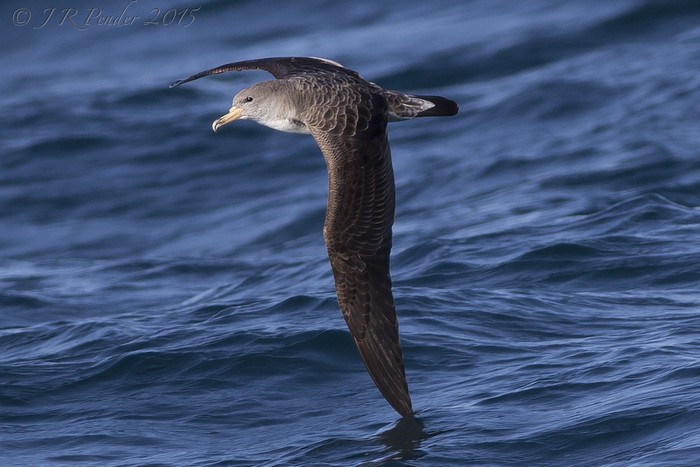
Cork birders scored highest for Cory’s Shearwaters through the rest of the week, with 28th yielding 116 from Galley Head (including a spurt of 107 in 90 minutes during the late morning) and 110 from Old Head of Kinsale the same day. A further 25+ were logged in the county during the rest of the week while the only other records for Ireland came from Clogher Head in Kerry, seen on 28th and Hook Head (Co. Wexford) on 30th.
In Cornwall, Porthgwarra managed 36 Cory’s on 27th and 70 the following day. Five (a 1 and a 4) were seen from a couple of Scillonian trips during the week while nine were seen from the Scilly pelagic of 27th and seven were seen from Bryher on 28th.
The most impressive report of the species this week though came from Cumbria where on 29th a single Cory’s Shearwater flew south past Walney Island for what could be the first record in the county since two in April 2002.
Upwards of 650 Balearic Shearwaters were noted by the end of the holiday weekend - thanks in no small part to Dorset’s 270+ (duplication always possibly given feeding flock movements) which included 96 and 130 off Portland Bill on 28th and 30th. As many as 80 were recorded in Kent, thanks to another good count from Dungeness on 27th when 55 were seen. Three modest counts came from Porthgwarra (14,18 and 29) while Devon managed another 150+ for the pot, including 50 off Prawle Point on 30th. At least 20 were seen from the Scillonian on 28th while dribs and drabs made it to the two Sussex counties and also to Norfolk and Suffolk across the Bank Holiday weekend.
Wales saw 18 birds noted in two counties, a dozen of them heading past Strumble Head (Pembrokeshire) on 29th (with one off Anglesey the same day) and further up the west coast was one in Dumfries and Galloway and two from Ardvule Point, South Uist (Outer Hebrides) on 28th - exactly three years to the day (and the location…) since the last Hebs record. A further lone bird drifted around the top of Highland, seen from Tarbet Ness on 30th.
There were minimal returns from Ireland - 10 birds in four counties, with five for Clare and three for Waterford.
There’s not much left to note re:- Long-tailed Skuas - the only records from post-26th were the fascinating report of 13 birds off the Scillonian on 27th, further at-sea birds, from Baltimore pelagics on 29th and 30th and one off Holme (Norfolk) on 1st.

Around 75 more Pomarine Skuas were mentioned through the rest of the week - 27 from four Irish counties (including nine on four days from Bridges of Ross, five from Donegal’s Rossan Point on 29th and nine off Annagh Head in Mayo on 30th) with 20 seen in five English counties (with six for Cornwall and three for Kent) while Strumble Head managed at least half a dozen through the week. Scotland managed three records, five seen from South Uist and one off Tarbet Ness, all on 30th and then Kinghorn (Fife) on 1st.
Along with the inevitable Sabine’s Gull in Highland’s Staffin Bay on 27th, nine more birds were logged this week - twos each for Bridges of Ross on 28th and Strumble Head on 29th with singles at the latter site on 30th and 31st and three there on 1st. Another Irish singleton was logged from Annagh Head on 30th.
Leach’s Storm-petrels were in short supply again this week (no surprise given the weather) but five were seen from Clare’s Bridges of Ross on 30th with another lone bird the same day noted from Ardvule Point, South Uist.
Rounding things off is Grey Phalarope and following on from the six of Bridges already mentioned for 26th, there were 20 more birds reported through the week. Bridges popped in another lone bird on 27th, with two seen from Clogher Head (Co.Kerry) and also from the Scillonian the same day. The 28th saw five pass Galley Head (Co. Cork) and another was seen off Bridges, while two more Scillonian birds were noted on 29th. Rounding things off, the seven noted from Strumble Head on 31st.
A genuinely nocturnal, heard only Night Heron was noted just after 11pm at the Arundel WWT on 27th while rather more obliging was the adult that remained at Swillington Ings (West Yorkshire) until 28th before appearing again on 1st. On the Somerset Levels, a juvenile or 1s Purple Heron was seen for three days around Ashcott Corner from 28th-30th.
On the Outer Hebrides, a Glossy Ibis, still a genuinely rare bird for the islands was found at Allasdale, on Barra on 30th - up until the end of 2012 there had been just two records for the Hebrides (in 1910 and 2012) but there’s been a small flurry of records since - five arrived on North Uist in October 2013 with further sightings of ones, twos, threes and fours coming from South Uist, Benbecula and Lewis off-and-on through to February of last year.
The shift from east to south where our week’s haul of Spoonbills was concerned became ever-more clear over the weekend; number shave built steadily in and around Poole Harbour in the past fortnight and the last seven days have seen numbers move from 15 to 17 and, by 31st, to 26 birds in all.
The coastal sites of Lincolnshire and Norfolk still held impressive flocks too though - Gibraltar Point’s weekly maximum was 17 on 26th-27th while Norfolk’s premier Spooner sites saw 22 counted at Stiffkey Fen on 27th (with 18 still around on 1st), 19 for Titchwell on 31st and 11 gathered at Burnham Norton, also on 27th. A further seven were noted elsewhere in Lincolnshire, including four at Frampton Marsh RSPB while up to four more were seen between west and north Norfolk.
Another double figure group, 10 in all, was noted at Fowley Isle, Conyer (Kent) on 30th and further south coast birds included two at Langstone Harbour (Hampshire) and one in Christchurch Harbour (Dorset) also on the same day. Back for a winter on the north Devon estuaries were the four Spoonbills that arrived on the Taw on 31st.
Inland birds were reported from Fen Drayton RSPB (Cambridgeshire) - two there on 30th - and also at Fairburn Ings RSPB (West Yorkshire), Croxden Quarry (Staffordshire) Willington GPs (Derbyshire) and then Holme Pierrepoint (Nottinghamshire) and Rutland Water (Leicestershire) on 29th, 30th, 31st and 1st respectively.
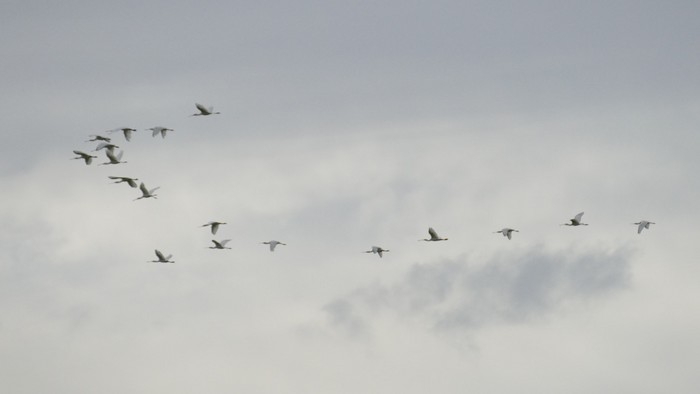
Two northwestern Spoonbills remained at Hesketh Out Marsh and Banks Marsh until 29th with another still on the estuary at Glasson while in East Yorkshire, two flew over Sunk Island on 28th and one was at Kilnsea on 29th.
In the Norfolk Broads, gathering of Common Cranes this week included 11 at Horsey on 27th and 17 at nearby West Somerton later the same day. Half a dozen birds, including a locally fledged juvenile) were at Goole Moors (East Yorkshire) on 31st with the only other record coming courtesy of the still-present bird at Blithfield Reservoir (Staffordshire), there until 29th.
Completing almost a third week on site was the Spotted Crake at Blacktoft Sands RSPB in East Yorkshire, still there until 28th at last. New for the roundup were two birds in Devon on the final day of the month; in the east, at Black Hole Marsh, near Seaton and in the south, at Bowling Green Marsh. The sole drifting Corncrake over the past seven days was seen on Fair Isle on 28th.
The drake Lesser Scaup that has spent the past two months (give or take a day or two here and there) at Blagdon Lake remained through until 26th before popping up at Chew Valley Lake on 30th, with the same site also played host to a female Ferruginous Duck on 28th-1st.
The only other duck of note this week was the drake Surf Scoter that remained in Lunan Bay (Angus) until 26th.
No doubting the best shorebird find of the week - the five-minute inland Broad-billed Sandpiper at Scorton GPs (North Yorkshire) on the morning of 26th. Only the third record for the county in the past 15 years, this record mirrors closely that of the adult that spent the day at Nosterfield LNR on August 26th 2012. (Nosterfield also hosted the only other North Yorks., bird, seen in May 2002.
Down in East Yorkshire, an adult Pacific or American Golden Plover was reported flying north past the seawatching hut on 31st - Spurn’s most recent record of the former was in July 2007, the latter was last recorded on this marvellous peninsula in 2013.
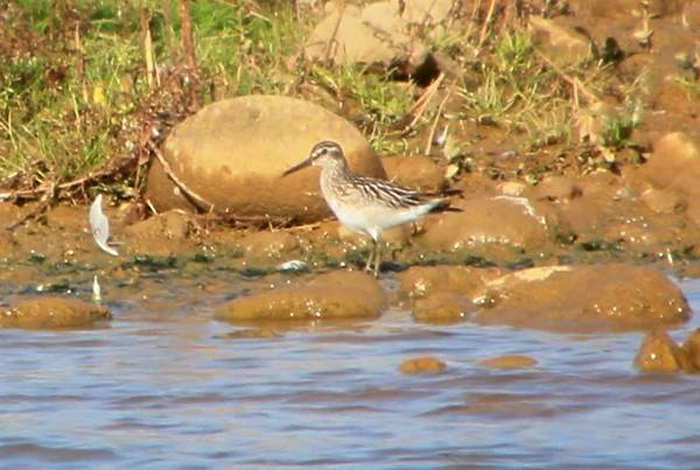
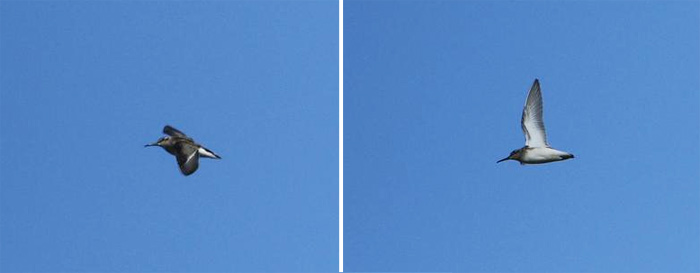
There were two reports of flying Dowitcher sp., during the last week - the first was as heading from White Island, St. Martin’s off towards Tean on 27th (apparently the second day there) and on 31st another was mentioned as flying north past Fraisthorpe (East Yorkshire) with a small group of Redshanks.
New for this week was the Buff-breasted Sandpiper that was seen on St. Mary’s (Scilly) on 30th while lingering Nearctic shorebird visitors included the fine adult Spotted Sandpiper at Coate Water Park (Wiltshire) - seen until 27th - and the adult Lesser Yellowlegs on the Conder Estuary, Glasson (Lancashire) until 26th.
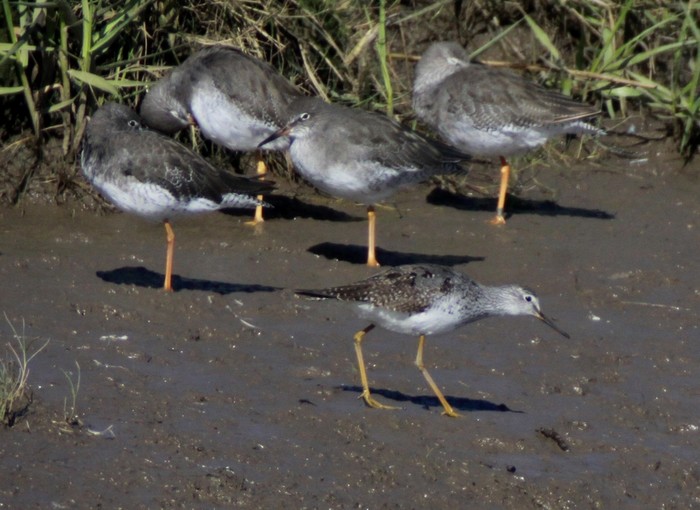
The week began with last week’s new juvenile Pectoral Sandpiper being noted as still present at Holywell Ponds (Northumberland) and it was followd by a further six birds; one remained near Kirkwall, Mainland (Orkney) through to 29th and at Tacumshin (Co. Wexford) a new bird this week stayed until 31st; other newbies were singles at Beddington SF (London) on 29th, Hickling Broad NWT (Norfolk) on 30th, Tresco’s Abbey Pool on 31st and Bishop Middleham (Co. Durham) on 1st.
There was another sizeable early autumn trip of Dotterels noted this week - hot on the heels of the 20 in north Norfolk noted in last week’s round-up, a gathering of 26 was found near Dover (Kent) on 27th, five of which remained to the following day. Just two others were found; a juvenile was at the Freshwater Bay Golf Course on the Isle of Wight from 28th-30th and August’s final day saw another lone bird appear on the Great Orme (Conwy).
A Red-necked Phalarope spent a day at Lincolnshire’s Frampton Marsh RSPB on 30th while Temminck’s Stints managed a total of eight in all; three remained at Seahouses (Northumberland) to 26th (with two in place until 30th at least); the 26th also saw singles logged at Gibraltar Point NNR and Minsmere RSPB; the 27th saw news of the continuing presence of the juvenile at Dungeness RSPB while 30th saw what may have been another new arrival appear at Gibraltar Point. The last one of the eight was found in Nottinghamshire, at Newington on 1st.
Finally, on the afternoon of 1st, was a Kentish Plover found in Poole Harbour, out on Brownsea Island. Makes a change from those old Spooners...
The juvenile White-winged Black Terns found last week in East Yorkshire remained at Hornsea Mere until the evening of 27th. The same date also saw the arrival of a new youngster to Dungeness and on the evening of 30th, it was joined by a second bird - the fifth and sixth birds for the site this year (and the second time there’ve been two on site in 2015, two were seen there in May as well) - they both lingered to 1st. A third new Kent bird flew down the river at Cliffe (with a group of Black Terns) on 31st.
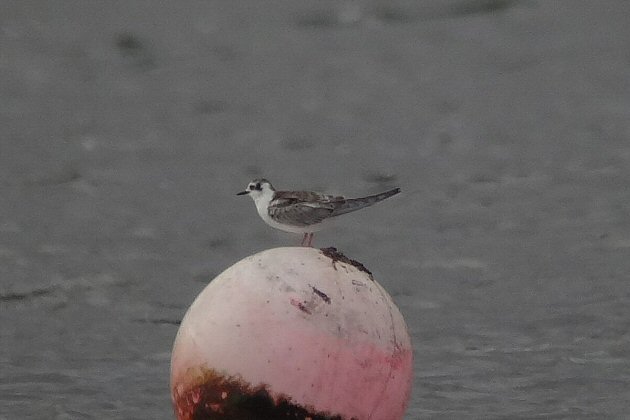
The fifth White-winged Black Tern of the week was a great find inland of another juvenile, this one coming to Willington GPs (Derbyshire) on the evening of 31st - the first in the county since a September youngster at Long Eaton in 2006.
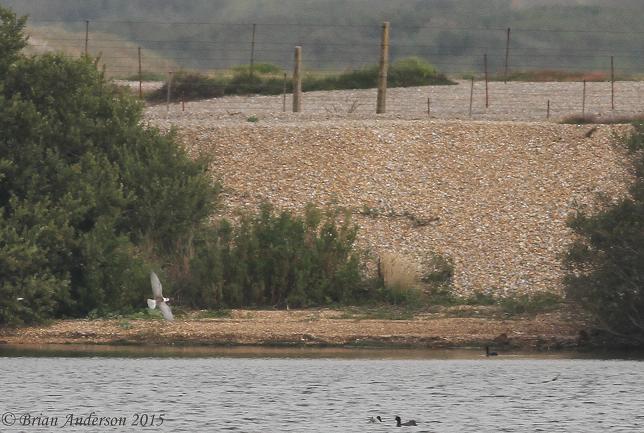
Over on the east coast of Ireland, at Soldier’s Point in County Louth, the recently returned adult Forster’s Tern remained to 26th.
There wasn’t much action in Larid-World either this week - a “new” second-winter Ring-billed Gull was seen at Padstow (Cornwall) on 27th - there’s been no sign of the Hayle bird this week (yes, you know where that line of thought is going...) - while Lancashire’s “2s” was still at Preston Dock until 1st. In Wales, a Ring-billed Gull appeared at Connah’s Quay (Flintshire) on 29th and an adult was seen in Derry, on the BAnn Estuary at Castlerock on 30th.
An old favourite was also back again - the adult Ring-billed Gull returned to Dingall, in Highland, on 27th; this individual was first seen on January 25th 2004 and hasn’t missed a single winter since.
The week’s only Iceland Gull was seen on the beach, at Birsay, Mainland (Orkney) on 30th while lone Glaucous Gulls were seen at Lerwick, Mainland (Shetland) on 29th and then Achnahaird (Highland) and Newbiggin-by-the-sea (Northumberland) on 1st.
In East Yorkshire, a juvenile Red-footed Falcon was again seen around both Easington and Kilnsea on 27th and 29th (presumably one of last week’s two in the area) while the lovely first-summer male remained at Willow Tree Fen LWT (Lincolnshire) through until 1st.
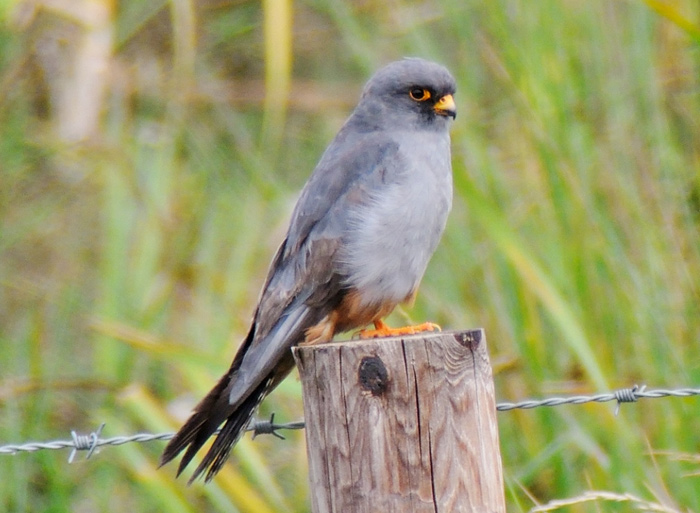
Four migrating Montagu’s Harriers were recorded through the past seven days; the first two were seen within five minutes of each other on the morning of 28th - one headed over London’s Brent Reservoir and a ringtail was reported from just east of Worksop (Nottinghamshire). The following day saw juveniles noted at Pulham St. Mary (Norfolk) and at Luccombe (Isle of Wight).
A rather perky tally of 38+ Honey Buzzards were logged this week, with the south coast and, in particular Kent faring well. Heading through day-by-day we start with two singles on 27th, seen at Worsop Vale (Nottinghamshire) and Gibraltar Point NNR (Lincolnshire); the 28th saw a lone bird noted again at the Wykeham Forest in North Yorkshire and then on 28th, at least 13 birds were seen across five English counties and one in Scotland too.
Six of that half dozen were in Kent, four of them flying out to sea from Hythe (and jolly impressive that must have been too), with singles at Dungeness and the Hemsted Forest. Two more HBs were at Beachy Head (East Sussex), one was at Pulborough Brooks RSPB in neighbouring West Sussex and in Hampshire, one was seen at Ripley. Away from the south coast, lone birds were reported from West Somerton (Norfolk) and Falkland (Fife).
Dungeness fared well on 30th, at least four there (with three together at lunchtime) and another was seen at nearby Lydd. Beachy Head birders saw their third in 24 hours and another made it up the Thames, to Rainham Marshes RSPB (London). The final birds of August were another for Hythe and East Sussex too, seen at Mount Caburn, on 31st and September’s first were seen over Holland Haven CP and Friton-on-Sea (Essex), back in Sussex, over Beachy Head and in the south Midlands at Westbury (Wiltshire) and near Stroud (Gloucestershire).
There’s much action to report again where all-things passerine are concerned and, as with last week, the main drift protagonists will surface somewhere towards the end. That means there’s plenty of time to relate to and inwardly digest news of the rarer oddments that rocked up in another busy, busy week.
The 23rd Lesser Grey Shrike for Norfolk spent a surprising half an hour in a garden near Cromer on 28th, departing to the southwest and to who-know’s-where. It is the first in the county for five years, since a fine male was seen between Kelling and Salthouse and the fifth record in the past eight years.
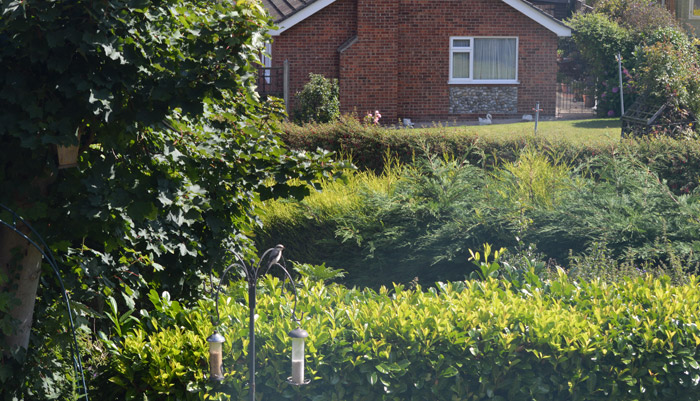
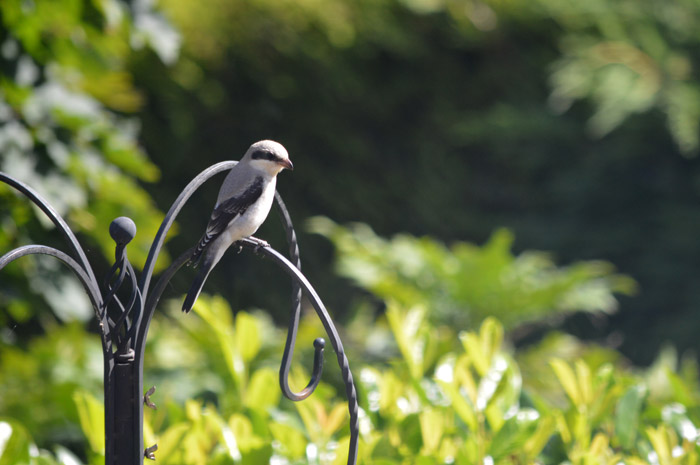
Two fresh juvenile Woodchat Shrikes found their ways across the English Channel, the first made landfall in Wiltshire, at Blakehill Farm NR (not far from the Cotswold Water Park) on 28th where it remained until the following day. This is just the second county record in the past 15 years, the only record recently being another juvenile, found near Middle Woodford in September 2001. The second Woodchat this week was found at Kynance Cove (Cornwall) on 30th, the eighth in the county this year.
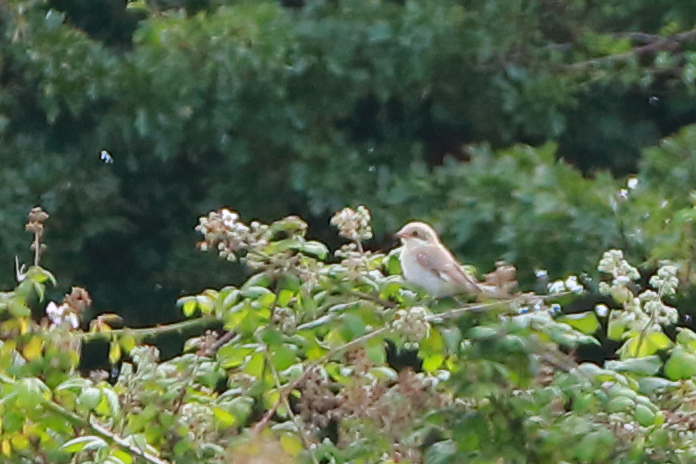
The week’s five Citrine Wagtails were spread from the Northern Isles to southeast Ireland and east Devon - a broad swathe of territory for this recently departed “BB” rare…last week’s superb first-winter found at Quendale Mill, Mainland (Shetland) remained to 26th and it was followed by further single 1w’s at Tacumshin (Co. Wexford) on 29th; on North Ronaldsay (Orkney) and Black Hole Marsh (Devon), both on 30th and on Fair Isle on 1st.
Since the first Wexford record was recorded at Tacumshin in September 2003, there have been a further 11 birds have been seen in the county - and of the dozen in all, nine have been at Wexford’s (and Europe’s…) premier rarity site (including twos in September 2011 and August 2013). Orkney has 20 previous Citrine Wagtail records prior to the new Ronaldsay bird (the 17th for the island but the first for two years) while the brief bird alongside the Rive Axe this week was the most significant of all - Devon has just one accepted record to date, a bird seen on Lundy on August 6th 1998.
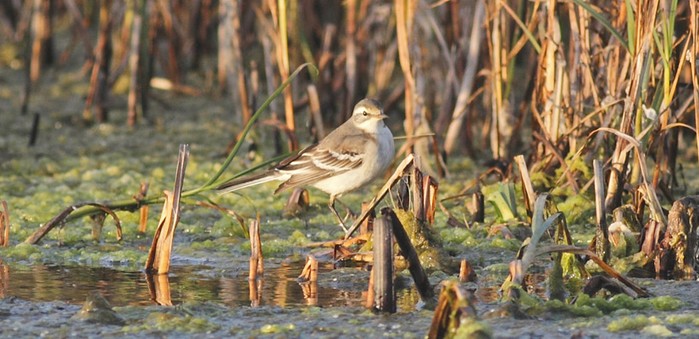
August has a strong track record of Citrine Wagtail occurrences - 69 on the books for the month by the end of 2013.
Two Western Bonelli’s Warblers were hangers-on from last week - but are absolutely worthy of continuing accolades.
First up, the bird at Portland Bill which, after three days of “missing-in-action” re-surfaced in the Bird Observatory nets on 26th but, aftr processing, it wasn’t seen again. On Scilly, at Sandy Lane, between Longstones and Telegraph, the Western Bonelli’s seen towards the back end of last week was noted again there on 27th.
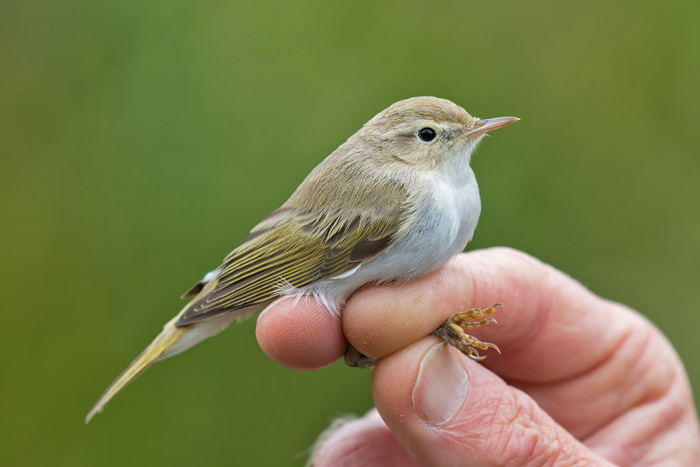
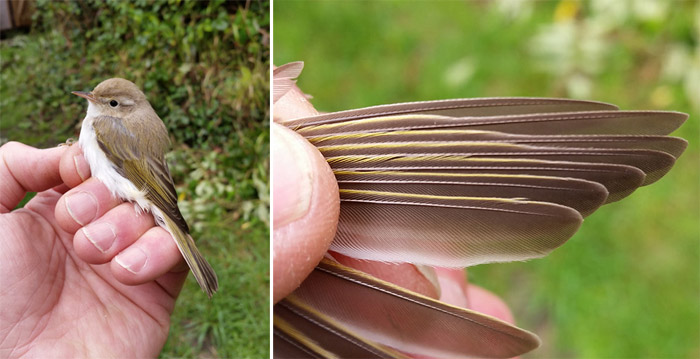
There were also two new Bonelli’s Warbler sp., to mention for this week - one was apparently photographed at East Soar Farm (Devon) on 27th - 29 years and a handful of days since a particularly fine, obliging Western Bonelli’s was noted at the same site - and a county first (whichever it may have been) was reported from Billinge (Lancashire) on 31st - a cracking record for the northwest region if accepted.
Shetland scored the second Arctic Warbler on the islands in four days thanks to the finding of one at the edge of the Loch of Spiggie, at Scousburgh on 28th while North Ronaldsay managed a lovely Greenish Warbler on the morning of 28th (with another reported briefly from Frampton Marsh on 30th).
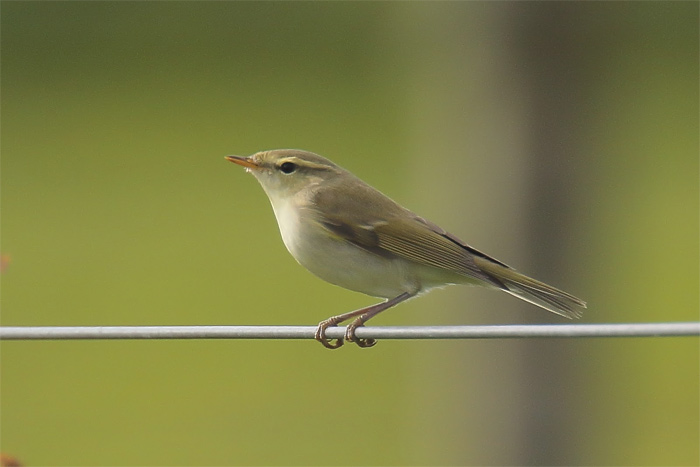
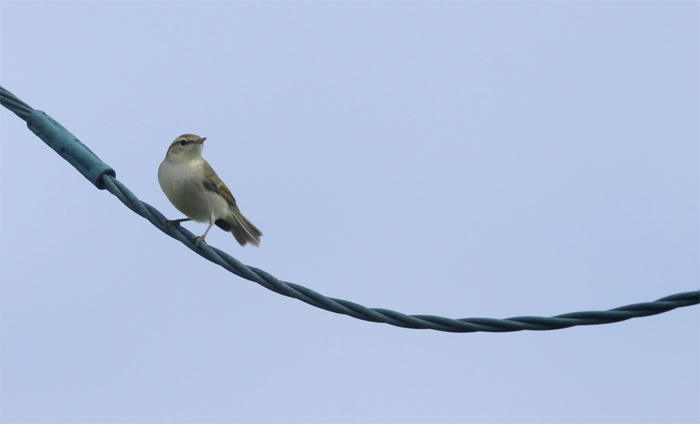
New as September 1st drew to a close was the male Subalpine Warbler sp., found near the Old Fall Hedge at Flamborough Head (East Yorkshire). For those outside of the immediate area, it could seem surprising that this is the first record of any of form of Subalpine since at least April 2003 (one reported but never appearing as “accepted” - the last record to get the green light from Flamborough was a male on June 5th-6th 2000).
This week’s bird was thought, most likely, to be of an Eastern type but let’s see what the assorted Sub-A experts come up with eh?
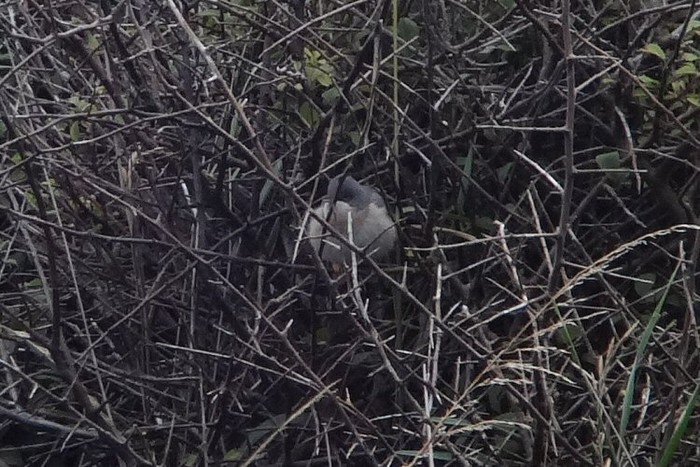
Shetland’s Melodious Warbler remained at Norwick, Unst until 27th while Portland snagged another one for the isle on 29th when one arrived in the Top Fields area of the Observatory recording area.
The warm waft of weather that seduced those Cattle Egrets into Dorset must have also managed to pick up the Kent Red-rumped Swallow that spent sometime at Dungeness RSPB on 30th and the Hoopoe at Sandwich Bay from 29th-1st. A second bird in the county was seen near Deal on 26th while, much further afield, were singles at Ardvarsar, Isle of Skye (Highland) from 26th-29th, near Wicklow (Co. Wicklow) on 30th and at Dancing Ledge (Dorset) and Carnyorth Common (Cornwall), both on 31st.
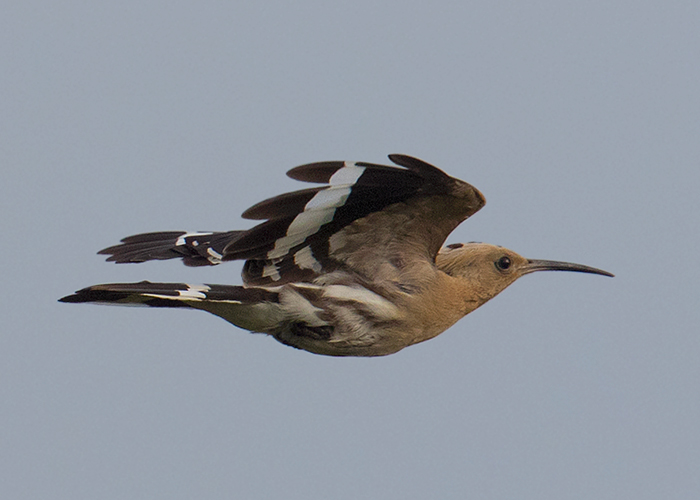
Two Rose-coloured Starlings were knocking around in the far northwest of Scotland through the week; one was noted in gardens in Stornoway, Lewis (Outer Hebrides) on 27th while in Highland, at Gairloch, the adult last reported in mid-August was still present to 28th at least. A confiding juvenile popped up at Portland Bill on 30th-31st and there also seems to have been a garden bird at Mullion (Cornwall) from 27th-30th. A second Cornish bird appeared on the review’s last day - near St. Levan on 1st.
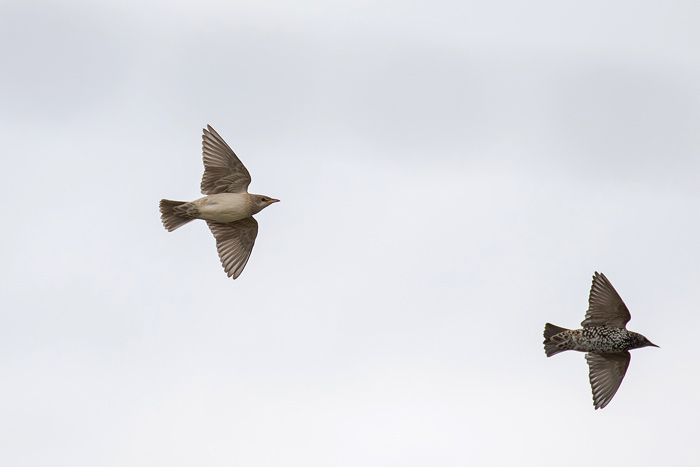
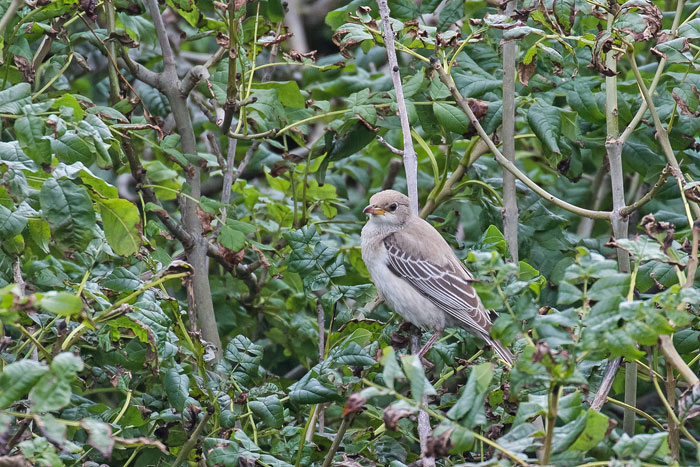
Here we go again then, with the breakdown of the primary species that so dominated the proceedings last week. The numbers may have be down on the super scores from seven days ago (markedly so in some cases) but the geographical spread of some species was much broader than seen previously.
Last week 80+; this week 22+.
A quarter of the number from seven days ago but that’s still a reasonable showing of Icterine Warblers. Shetland claimed the lion’s share - up to 11 around the islands, including five on Fair Isle on 26th (with three on 27th and two on 28th). Up to four were seen on North Ronaldsay (Orkney) including three on 26th and one was also noted in Lothian, at Torness, on 26th.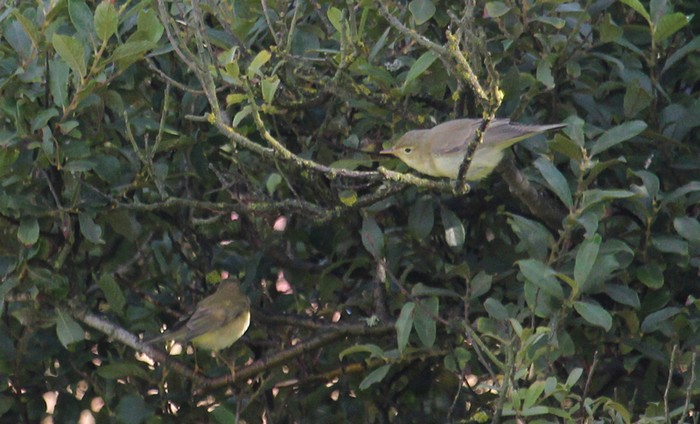
Up to four birds were seen in northeastern England, three of them found on 31st; at Sammy’s Point and Kilnsea (East Yorkshire) and Holy Island (Northumberland) with perhaps another at the latter site on 1st while in East Anglia, one or two Icterines were seen around Thorpeness (Suffolk) on 27th-28th while a singing bird in Cherry Hinton (Cambridgeshire) on 30th is the first county bird since June 2008. The only bird noted in southeast England was found at Dungeness RSPB (Kent) on 31st and which was still present on 1st.
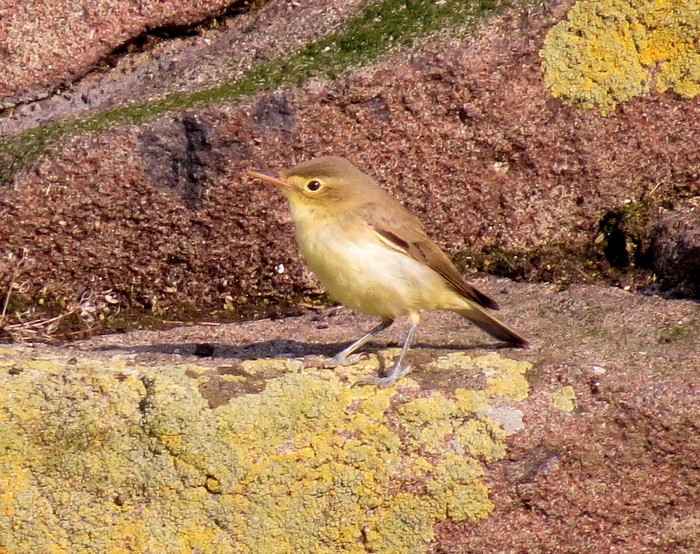
Last week c.47; this week 25.
As with seven days ago, it was Scotland that came out on top where Barred Warbler records were concerned, 15 noted around the country, with up to eight on Shetland (including three on Fair Isle on 26th - with another on 1st - with two singles on Unst and ones on both Noss and Yell) and on Orkney, two fresh arrivals came to North Ronaldsay on 1st. There were also lone birds seen, all on 26th, at Wick (Highland), on the Isle of May (Fife) and at St. Abb’s Head (Borders).
Northumberland birders found a Barred Warbler at Tynemouth on 1st and further down the coast in East Yorkshire, at least three birds were noted between Easington and Spurn on 26th while two birds found their way to Lincolnshire (at Gibraltar Point from 29th and Saltfleetby on 30th) and another was seen at Marsden Quarry (Co. Durham) on 31st. The only others this week were separate birds on Norfolk’s Blakeney Point, one at The Hood on 30th and one in the Lupins on 31st and also in Suffolk, at Lowestoft on 1st.
Last week 52; this week 40.
Red-backed Shrike has had a decent enough week and, just as with other species mentioned here, it was again (unsurprisingly) Scottish islands and the northeast of England that pulled in most records through the past few days. A minimum 13 were found around Shetland, with four around Mainland, three each for Fair Isle (from 26th-31st) and Unst (including two at Norwick on 27th) and one on Yell. An Orcadian single was at Deerness, Mainland from 26th-29th and on the Outer Hebrides, a juvenile was found at Knockintorran, North Uist on 31st - the first for that island since May 2008.
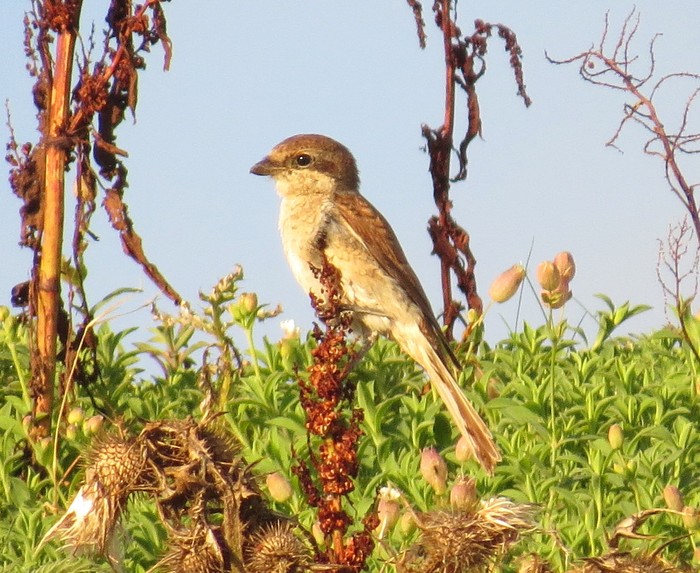
Not far behind the Scottish total was the northeast of England where at least 13 birds were found this week. Up to eight were in East Yorkshire, including two at Kilnsea on 29th and two new arrivals on 31st (at Flamborough and Sammy’s Point); a male was on the border of South Yorkshire & Lincolnshire, at Thorne Moors on 26th; two were in Lincolnshire, at Gibraltar Point on 27th and the more unlikely confines of ground adjacent to Grimsby Town FC from 29th while Northumberland saw singles drop on to Holy Island and East Chevington NWT on 30th. A notable juvenile was found on the final day of the review, September 1st, at Sunderland Point (Lancashire) - the first for almost two years in the northwestern county.
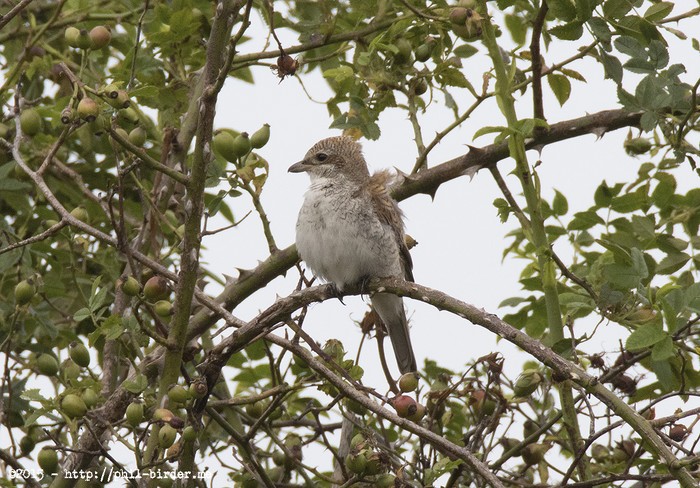
Up to eight Red-backed Shrikes were in Norfolk - with perhaps two at Winterton and two on Blakeney Point on 1st, with singles at Sea Palling, Kelling, Burnham Overy and Titchwell RSPB and two were in Suffolk, at Southwold on 26th and Minsmere RSPB on 1st. A new juvenile was a good find in Colchester (Essex) and 1st while in West Sussex new loners were at Pagham Harbour on 28th-29th and Climping on 30th-31st.
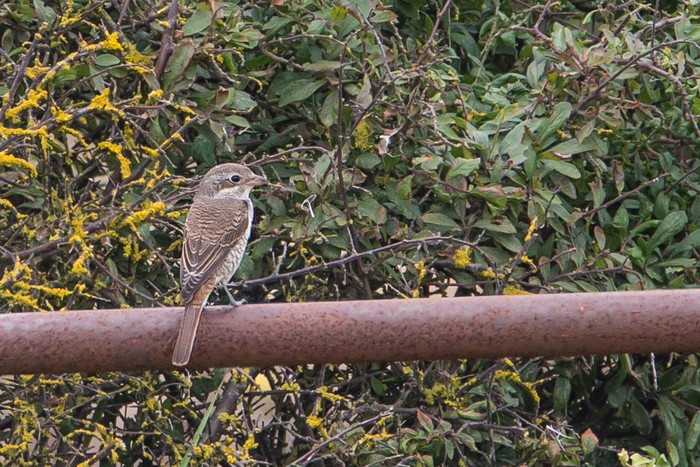
Last week 130+; this week 90+.
Perhaps more than any of the other “main” drifters reported in the past two weeks, Wryneck has done what it so often has done in the past - arrive on a broad front across the north of Britain and east coast too and then work a way inland and south.
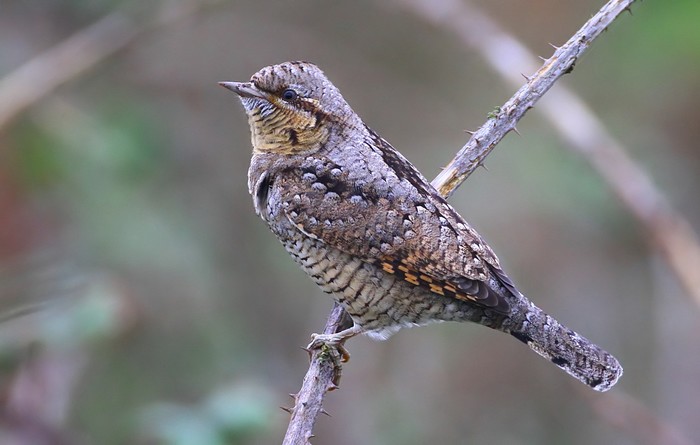
Working a way around Britain and Ireland, we’ll start in Scotland were this week just four birds were noted, all of them on Orkney and all on 26th (including two on North Ronaldsay). The northeast of England managed some 10 birds in all, with four around the Spurn area on 26th and four in Lincolnshire (with two at Gibraltar Point on 29th). In the northwest, a garden bird was in Southport for three days from 28th while inland in the Midlands, singles were found at Swallowcliffe (Wiltshire) on 26th, Ashfordby (Leicestershire) on 27th, Harrington (Northamptonshire) on 28th and at Berry Hill Fields NR (Staffordshire) on 31st-1st.
East Anglia’s three counties shared the 19 regional Wrynecks out with seven for Norfolk, six for Suffolk and two for Cambridgeshire - those totals included two each at Corton and Winterton on 28th while the Fenland county managed singles at King’s Dyke on 29th and Pymoor on 30th.
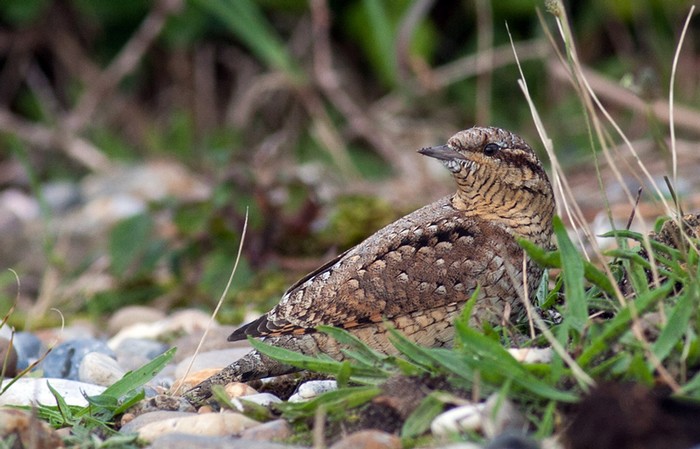
Numbers through southeast England picked up markedly from last week, at least 26 mentioned in all; there were five in Kent and fours for London, West Sussex and East Sussex too, while Hampshire managed five. Three were seen in Essex, two found a path to Oxfordshire - one found at Otmoor RSPB on 29th and another made it to Wantage on 31st while two made it to Hertfordshire, noted at Hitchin on 31st and Batford on 1st.
The southwest scooped up at least 21 Wrynecks with Dorset managing seven and Cornwall eight. Devon popped in four and there were ones for both Somerset and Scilly. Ireland managed one bird last week and went one better this week thanks to birds out on Great Saltee Island (Co. Wexford) on 29th and Blacksod, The Mullet (Co. Mayo) on 1st.
In amongst the “regulars” came a handful of further, scarcer drift species - first up three Marsh Warblers - the first off which made landfall on Inner Farne on 28th but sadly it died there later the same day. Also on 28th was a report of one at Snettisham RSPB (Norfolk) and the 30th brought one to St. Mary’s (Scilly).
Two Common Rosefinches were new to North Ronaldsay on 26th and one hit Fair Isle on 1st while fresh Ortolan Buntings appeared at Spurn (East Yorkshire) on 27th and at Cogden Beach (Dorset) on 30th.
A couple of Bluethroats were found on 29th; the first being trapped and ringed at Lytchett Bay (Dorset) and the second, an often showy male, was at Winterton (Norfolk). A second bird was reported nearby on 30th while the original Winterton bird was singing by close of play on Sunday.
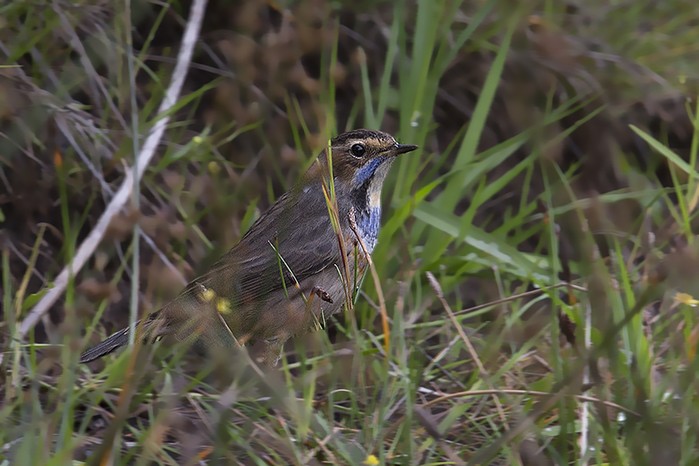
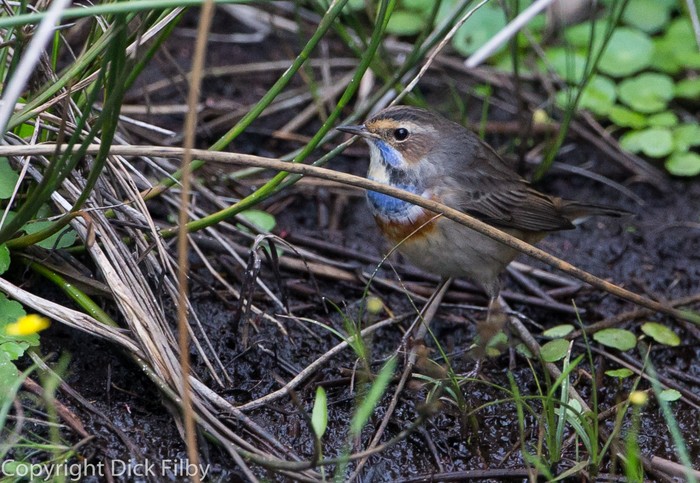
Happy news emerged from the breeding Cumbrian Bee-eaters at the Lower Gelt Quarry, near Brampton on 31st, at least one juvenile seems to have made it through the breeding process, three adults noted again too on the Big Bee-eater Birthday. Several overshoots also arrived through the week - the most notable of which was the flock of seven found at Veensgarth, Mainland (Shetland) on 26th with at least four in place in the area until 28th.
A Bee-eater spent a short while on wires at St. Fergus (Aberdeenshire) on 27th and the following day saw another single head over Great Orme (Conwy). The 29th saw the (presumed) reappearance of the Aberdeenshire bird, this time at Loch of Strathbeg and also Collieston another headed over Dorset’s Hengistbury Head the same day. Also in Dorset on 29th, two birds over the Purbeck cliffs between Swanage and Corfe Castle.
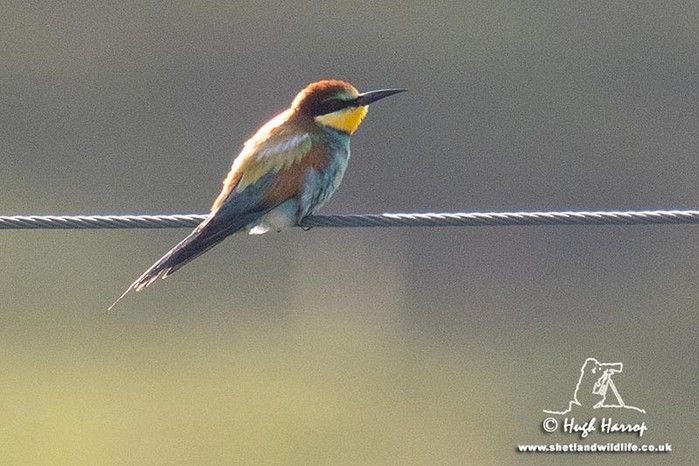
Weather conditions become ever-more critical for the rare-minded birder and early September is awash with the quirky, the fascinating, the down-right outrageous and also the somewhat contemplative (certainly in terms of one ever-diminishing species…).
Shetland could really start to come in to its own in the next few days, should the weather suit - September 2nd 2011 saw an Eastern Olivaceous Warbler make landfall on Fair Isle while there’s five-for’s for both Booted Warbler and Western Bonelli’s Warbler as well.
Those who’d perhaps like to chance their arm at finding an Arctic Warbler may like to keep the factoid that 10 of the chunky wing-barred beasties have been located on previous 02/09’s in the back of their minds too…
…indeed, the same tally for P.borealis is on the record books for September 4th, 5th and 6th as well.
Early Lanceolated Warblers have made it to Fair Isle on September 4th (2000), September 7th (2002) and September 8th (1978) - with the latter date seeing on appear on North Ronaldsay (on 2008) and the weather gives half a thought that there could be one of these found coming “around the top” in the next week - and what odds on another early Pallas’s Grasshopper Warbler? That Titchfiled bird last year was found on 6th…
The middle dates of the week ahead - 5th and 6th - are the ones to have paid out BIG time - Britain’s fourth Brown Flycatcher was found at Buckton in September 5th 2010, while the third British Tennessee Warbler was trapped at Holm, Mainland Orkney on September 5th 1982 and our first Purple Martin was located over the Butt of Lewis on 050904.
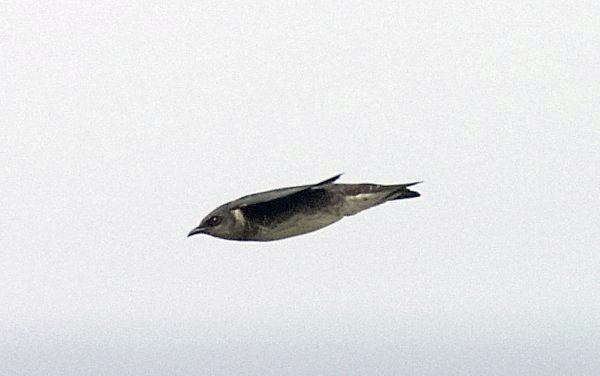
Talking of “first records” and nipping swiftly back to Tennessee Warbler, Fair Isle laid claim to that one on September 6th 1975 (the second came just over two weeks later) - and the most recent was 20 years ago this month, on inaccessible St. Kilda.
Shorebird fans may like to keep eyes open for Great Snipe and Wilson’s Phalarope on 6th - 11 of the latter and 12 of the former have been found previously…
There’s one species whose figures make for almost haunting reading through the week ahead - once a regular fixture from very late August to the end of September, the continuing demise of Yellow-breasted Bunting is well known and has been discussed here and in may other places online over the past few years.
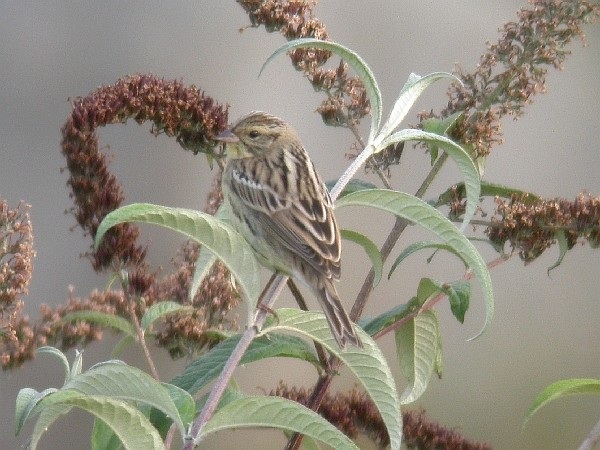
The day by day stats for the seven days ahead make for sobering reading…
September 2nd - five records - most recent occurrence; Skelberry, Mainland Shetland, 2000
September 3rd - six records - most recent occurrence; Portland Bill, Dorset, 2003
September 4th - eight records - most recent occurrence; Spurn, North Ronaldsay and Fair Isle, 1996
September 5th - ten records - most recent occurrence; Brownsman, Farnes, 2013
September 6th - five records - most recent occurrence; Foula, Shetland 1997
September 7th - six records - most recent occurrence; Fair Isle, Shetland 2003
September 8th - nine records - most recent occurrence; Sumburgh, Mainland Shetland 2002
Grim stats reveal just one really recent Yellow-breasted Bunting, the bird seen for three days on Farnes in 2013 - that is just one of 11 seen here in the past decade (out of an overall total of 233 acceptances on all), with just two of those coming in the past five years (on Foula in 2011, along with the 2013 bird above).
Figures were healthy-ish between 2000 and the end of 2004; seven birds in 2000, three in 2001, six in 2002 and 2003 with two in 2004 making a total of 24 in all. Eight more followed in the five years from the start of 2005 to the end of 2009 and there have been just three since.
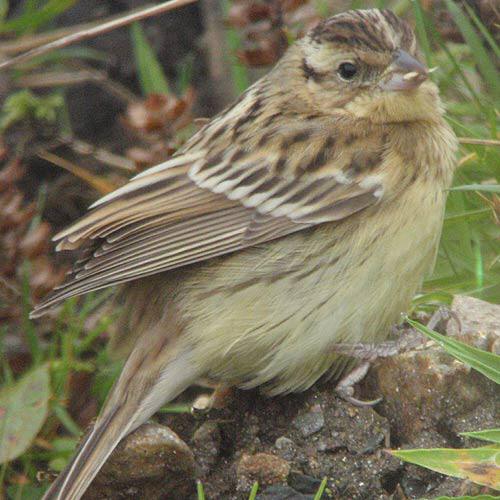
This really is a species in serious trouble…and it is hard to see it improving anytime soon.
A lucky few on the Northumberland coast were treated to two spectacles of the natural world this week...The first came in the shape of another brilliant display of the Aurora Borealis captured below by Jonathan Farooqi late on the evening of 27th.
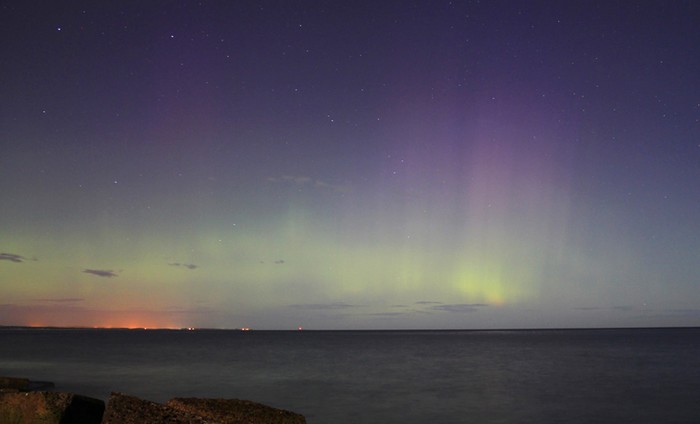
The second came in the shape of two Beluga Whales seen off Warkworth Beach, Northumberland on 31st with a single Beluga first sighted in the area on the day before!
.
Mark Golley
02 Sep 2015
Please note: we put a lot of time and effort into sourcing and and producing the images, videos and graphics for each roundup. Some of you (probably Apple users) may notice some photos etc. that appear to have incorrect captions. Please try refreshing the page as they are correcty captioned. If after a refresh they are still showing the incorrect captions then please email us











